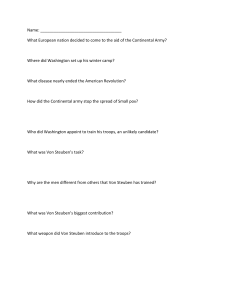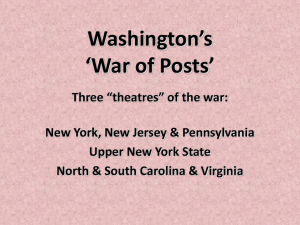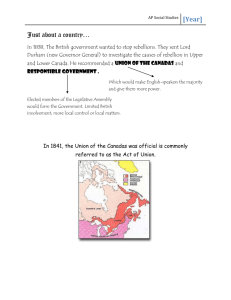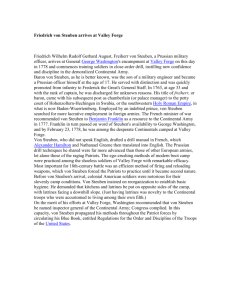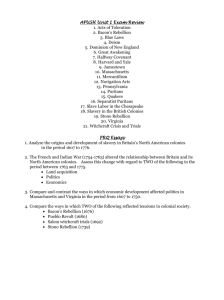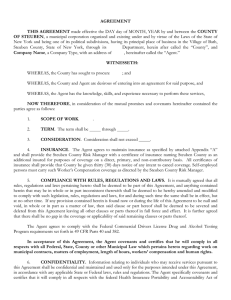The American Revolution
advertisement
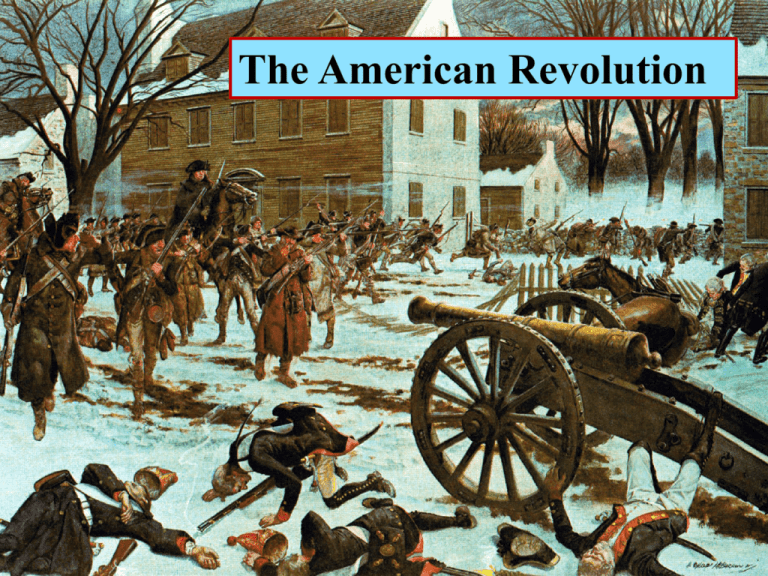
The American Revolution What you need to do . . . • Understand the operational over-view of the Revolution. • Understand Washington’s strengths and weaknesses. • Understand the military policy of the Revolutionary government – Militia – Continental Troops – Von Steuben’s role Reasons . . . • Period of “Salutary Neglect” prior to 1763. • British attempts to re-structure imperial control after 1763. • Difference in British and American visions of America’s place in the Empire. American View: Imperial Government Great Britain American Colonies British View: Great Britain American Colonies Other Colonies Objectives • Americans = Independence • British = Suppression of the rebellion Center(s) of Gravity ? British Center of Gravity National Political Will American Center of Gravity Washington’s Political Will Congress Army Friction Americans • Training • Leadership • Civilian support British • Initial lack of resolve? • Distance • French entry into the war • National will • Political considerations cause Washington to defend New York. • Howe is slow. • Washington evacuates New York. (< 3000 men) • Valcour Island provides hope. • Washington’s winter offensive. • British fall back into NYC and Newport. Lessons learned . . . Americans • Washington could not fight the way he wanted. British • Americans were better than they thought. • Washington was good q(or at least good enough). Washington’s operational strategy . . . Strategic Defense • The Revolution continues as long as there is an Army. • Do not risk the Continental Army again to defend a city. • Be just aggressive enough to: – Keep up American morale – Cause the British to loose heart. Washington opts to win by not loosing. “We must take things as they are and not as we wish them to be.” BG Edmund Gaines, 1818 [ Means vs. Ends ] British campaign plan . . . • Using three converging forces: – Capture Albany – Destroy American forces – Cut off and isolate New England • Burgoyne moves south from Quebec. • St. Leger moves east from Ft. Oswego. • Howe was assumed to be moving north from New York City. • Washington unsuccessfully defends Philadelphia. • But . . . St. Leger stopped at Ft. Stanwix, Burgoyne surrenders at Saratoga. “Now is the winter of our discontent . . .” (1777-1778) • British hold New York City, Newport, and Philadelphia. • Americans in winter camp at Valley Forge. – Frederick von Steuben become Inspector General – Nathaniel Green become QM General • France signs “Treaty of Alliance” with U.S. (February 1778) – 1779 Spain declares war on Britain, – 1780 the Dutch declare war on Britain Fredrick Wilhelm von Steuben “My good republicans wanted everything in the English style; our great and good allies everything in the French mode; and when I presented a plate of sauerkraut dressed in the Prussian style they all wanted to throw it out the window. Nevertheless by the force of proving by Goddams that my cookery was the best, I overcame the prejudices of the former; but the second liked me as little in the forests of America as they did on the plains of Rossbach.” von Steuben to Baron von der Glotz, Prussian Ambassador in Paris British view of the facts, 1778 . . . • • • • • War no longer confined to N. America. Significant French threat in the Caribbean. American colonies now a secondary theater. No success in the Northern colonies. Southern colonies offer a better chance: – Southerners fear slave rebellion and Indians, – Greater Loyalist support in the South. • Dec. 1778, Savannah falls. • May 1780, Charleston surrenders. • Tarleton destroys S.C. force at the Waxhaws. Now little resistance in the South. • 1779-80, horrible winter at Morristown. • Gates given command in the South. • Arnold’s treason. The tide turns . . . • July 1780, French force lands at Newport, RI. • British occupation policies in the South alienate neutral colonists -- guerrilla war. • Green replaces Gates as commander in South. • Americans fight but don’t win. • British “win” but at great cost and can never destroy Greene. • Green leads them on a chase into Virginia qqqqqqqqqq…and to Yorktown. York River Cornwallis established a secure position that could easily be supported by the Royal Navy. York River First Parallel York River “Sapping Forward” York River Second Parallel York River York River Creating a Breach York River Storming the Breach (nobody wants this to happen). York River Cornwallis surrenders 19 October 1781. Yorktown . . . the stats. U.S. 5,700 Continentals 3,100 Militia 7,000 French 2 French naval squadrons British 8,000 Regulars and Loyalists The end game . . . • Yorktown (1781) ends the fighting. • British remain in NYC • Treaty of Paris of 1783 officially ends war. – We sign a separate peace with the British – British recognize independence (on paper) • Our most bloody war after the Civil War. Army demobilized. What do we need it for ? International legacy . . . • American Revolution was ideological. • The restraint that characterized Continental warfare gave way in the Southern campaign. Washington’s legacy . . . • Emphasis on conventional operations. (The British model) – Organization – Training – Logistics • • • • Subordinate to civilian authority. Personal leadership. Effective political (people) skills. Dedication, risk, and self-sacrifice. After the Revolution • Shey’s Rebellion • Operations in Ohio – Josiah Harmer Expedition (19–22 October 1790) – Arthur St. Clair Expedition (4 November, 1791) • 1st and 2nd Militia Acts, 1792 • Whiskey Rebellion • Anthony Wayne Expedition (20 August, 1792) – Legion of the United States Legion of the United States (Rifle) (Rifle) 5,120 (Rifle) (Rifle) Von Steuben’s “Blue Book” William Duane 1810
